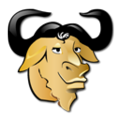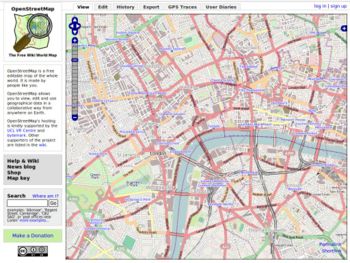Difference between revisions of "Free and open-source software"
| Line 20: | Line 20: | ||
{{portalpageend}} | {{portalpageend}} | ||
| − | |||
| − | |||
| − | |||
| − | |||
| − | |||
| − | |||
| − | |||
| − | |||
| − | |||
| − | |||
==Beyond software== | ==Beyond software== | ||
Revision as of 22:27, 14 January 2007
|
Free and open-source software (also known simply as Free software or Open source software) is software created by loose networks of people (both companies and individuals) who collaborate for mutual benefit. The software they produce is also made available for anyone else to freely download, use and modify because the developers also publish the human readable source code
 used to create it. used to create it.
Making source code available means anyone with the programming ability can customise the software for their own ends or contribute to the development project directly. Others can help by reporting bugs and helping with documentation or translation efforts. So this encouragement of interaction between users and developers, and some users becoming developers, creates a positive feedback loop in the software's evolution. Open source is becoming a very prominent method of software production and poses a serious challenge to commercial products - as the quality of open-source software approaches and supercedes commercial software, how will software companies compete with free? Although 'free software' is usually free of charge, the 'free' in the title actually refers to the user's freedoms to use, modify and redistribute the software. It should be also noted that 'Free software' is not the same thing as 'freeware' or 'shareware' which although they might be free to download, do not usually come with source code and cannot be freely modified or redistributed.
This methodology originated with software development but is certainly not limited to it. A notable example beyond software is the 'open content' Wikipedia
 , the famous collaborative encyclopaedia which is accessible and editable by anyone with a web browser. Its founder Jimmy Wales ambitiously states that he wants to capture the knowledge of all humanity and make it freely accessible to everyone - and the project to date is a very impressive start. It was began in 2001 and is now the largest and most comprehensive encyclopaedia in the world, grown organically by the contributions (and editing) of thousands of users, and the overall quality of articles on the whole is surprisingly good. See this article (2005) from the journal Nature comparing Wikipedia to Encyclopedia Britannica. , the famous collaborative encyclopaedia which is accessible and editable by anyone with a web browser. Its founder Jimmy Wales ambitiously states that he wants to capture the knowledge of all humanity and make it freely accessible to everyone - and the project to date is a very impressive start. It was began in 2001 and is now the largest and most comprehensive encyclopaedia in the world, grown organically by the contributions (and editing) of thousands of users, and the overall quality of articles on the whole is surprisingly good. See this article (2005) from the journal Nature comparing Wikipedia to Encyclopedia Britannica.
With a few built-in mechanisms to make sure the project doesn't dissolve into total chaos, the result is that this pool of knowledge is assembled and edited by people who want to do it and is now an amazing resource for anyone wanting a basic introduction to almost any subject. No-one is paying them to do it and no-one is telling them to do it, they contribute because they want to. It feels like the right thing to do - they are contributing to something greater. Contributors' know their efforts will be used and appreciated by thousands of other people, and that others are doing likewise. It is worth noting that like all encyclopaedias Wikipedia is not a 'primary source' for information and should be considered only as providing a useful introduction to a topic. It is always worth cross-referencing information from other sources too. It is apparent that these methods could also be applied to the design of physical machines and artefacts. With this development model designs, photos, instructions and CAD models are stored on the internet for others to use and improve upon. Design and engineering is arguably even more suited to this method than software design. This is because looking at a CAD model, especially if animated, allows an intuitive understanding of how the object functions, whereas software is composed of reams of (often obscure) programming code. Architecture is another area well-suited to open collaboration, as the Open Architecture Network has proved. See also
OpenStreetMap
So what about free riders? What happens when there are people who only take and never give anything back? Well, nothing really. Contributors are not expecting a specific quid pro quo arrangement — they get plenty in return from using other things in the universal commons. This is the essence of a post-scarcity economy; when a resource is abundant, it can be given away without expecting anything in return. If it is trivial to duplicate the results of someone's efforts then the more people who are able to make use of it, the better. The situation is not zero-sum — people are not going without as a direct result of someone else having it. A situation of abundance currently exists with regard to information on the Internet; it is free to replicate, I can give it to others without going without it myself, and as a result, people give it away freely and take it freely. Consider free and open-source software where anyone with a computer and internet connection can download the Firefox web browser or OpenOffice office software for free. Most people will be consumers rather than contributors, but this is of no consequence. After a while of enjoying the fruits of open-source, many people are only too happy to contribute in some way, giving back to the community that has provided for them. The fact that they are not required to do this, in many instances makes it more likely that people will do so, uncoerced. This is human nature. Wikipedia articlesOrganisations
Documents and articles
Software links
There are many more quality free and open-source software listed in examples of free and open-source software... FootnoteThe content management software that manages this website is open source and is called MediaWiki; and the server computer that hosts it is running a version of the Linux operating system called Debian |
 [print version]
[print version]  [update]
[update]  [site map]
[site map]
Beyond software
This methodology is not limited to software. A noteable example beyond software is the 'open content' Wikipedia, the famous collaborative encyclopaedia which is accessible and editable by anyone with a web browser. It founder ambitiously states that he wants to capture the knowledge of all humanity - and it is a most impressive start. It was started in 2001 and is now the largest and most comprehensive encyclopaedia in the world grown organically by the contributions (and editing) of thousands of users, and the overall quality of articles on the whole is surprisingly good. See this article from the journal Nature.
With a few built-in mechanisms to make sure the project doesn't dissolve into total chaos, the result is that this pool of knowledge is assembled and edited by people who want to do it and is now an amazing resource for anyone wanting a basic introduction to almost any subject. No-one is paying them to do it and no-one is telling them to do it, they contribute because they want to. It feels like the right thing to do - they are contributing to something greater. Contributors' know their efforts will be used and appreciated by thousands of other people, and that others are doing likewise.
It is apparent that these methods could also be applied to the design of physical machines and artefacts. With this development model designs, photos, instructions and CAD models are stored on the internet for others to use and improve upon. Design and engineering is arguably even more suited to this method than software design. This is because looking at a CAD model (especially if animated) allows an intuitive understanding of how the object functions, whereas software is composed of reams of (often obscure) programming code.
For further information on the open-source method applied to design and engineering see open collaborative design.
External links
Organisations
- Free software foundation (FSF) website
- Open Source Initiative (OSI) website
Documents and articles
- FSF Free software definition
- OSI Open source definition
- The Cathedral and the Bazaar - an interesting essay on why the 'bazaar' model of open-source software development works well.
Software links
- Wikipedia list of open source software packages
- http://www.linux.org Free and open-source operating system
- http://www.OpenOffice.org Free and open-source office productivity software - word processor, spreadsheer, presentation software, database etc.
- http://www.mozilla.org/products/firefox Free and open-source web browser
- http://www.gimp.org Free and open source 2D bitmap-graphics editor
- http://www.blender.org Free and open-source 3D graphics modeller, animator and renderer
- The content management software that manages this website is open source and is called MediaWiki; and the server computer that hosts it is running a version of the Linux operating system called Debian which in turn is running the Apache http server program (which runs 60%, or so, of websites worldwide), and PHP and the MySQL database.


